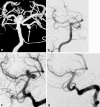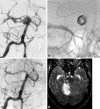Superior cerebellar artery aneurysms: incidence, clinical presentation and midterm outcome of endovascular treatment
- PMID: 17609935
- PMCID: PMC2039855
- DOI: 10.1007/s00234-007-0251-z
Superior cerebellar artery aneurysms: incidence, clinical presentation and midterm outcome of endovascular treatment
Abstract
Introduction: The aim of this retrospective study was to determine the incidence, clinical presentation and midterm clinical and imaging outcome of endovascular treatment of 34 superior cerebellar artery (SCA) aneurysms in 33 patients.
Methods: Between January 1995 and January 2007, 2,112 aneurysms were treated in our institution, and 36 aneurysms in 35 patients were located on the SCA (incidence 1.7%). Two of three distal SCA aneurysms were excluded. All the remaining 34 SCA aneurysms, of which 22 (65%) were ruptured and 12 (35%) were unruptured, in 33 patients were treated by endovascular techniques. There were 6 men and 27 women ranging from 29-72 years. In 14 patients (42%) multiple aneurysms were present.
Results: Initial angiographic occlusion was (near) complete in 32 aneurysms (94%) and incomplete in 2 aneurysms (6%). Complications leading to permanent morbidity or death occurred in two patients (6.1%, 95% CI 0.6 to 20.60%). Outcome at 6 months follow-up in 31 surviving patients was GOS5 in 26 (84%), GOS4 in 4 (13%) and GOS3 in 1 patient (3%). There were no episodes of (re)bleeding during 118 patient-years of follow-up. The 6-month angiographic follow up in 28 SCA aneurysms and extended angiographic follow-up in 19 showed stable occlusion in 27 aneurysms. No additional treatments were performed.
Conclusion: SCA aneurysms are rare with an incidence of 1.7% of treated aneurysms at our institution. They are frequently associated with other aneurysms. Endovascular treatment is effective and safe in excluding the aneurysms from the circulation.
Figures



Similar articles
-
Endovascular coil embolization of ruptured and unruptured posterior circulation aneurysms: review of a 10-year experience.Neurosurgery. 2007 Apr;60(4):626-36; discussion 636-7. doi: 10.1227/01.NEU.0000255433.47044.8F. Neurosurgery. 2007. PMID: 17415199
-
Distal aneurysms of cerebellar arteries: incidence, clinical presentation, and outcome of endovascular parent vessel occlusion.AJNR Am J Neuroradiol. 2007 Sep;28(8):1573-8. doi: 10.3174/ajnr.A0607. AJNR Am J Neuroradiol. 2007. PMID: 17846215 Free PMC article.
-
Endovascular treatment of basilar tip aneurysms with Guglielmi detachable coils: predictors of immediate and long-term results with multivariate analysis 6-year experience.Radiology. 2003 Mar;226(3):867-79. doi: 10.1148/radiol.2263011957. Epub 2003 Jan 24. Radiology. 2003. PMID: 12601216
-
Endovascular Treatment for Peripheral Superior Cerebellar Artery Aneurysms: Current State and Future Considerations.World Neurosurg. 2019 Jul;127:423-433. doi: 10.1016/j.wneu.2019.04.145. Epub 2019 Apr 25. World Neurosurg. 2019. PMID: 31028980 Review.
-
Clinical and anatomic outcomes after endovascular coiling of middle cerebral artery aneurysms: report on 30 treated aneurysms and review of the literature.Surg Neurol. 2006 Aug;66(2):167-71; discussion 171. doi: 10.1016/j.surneu.2005.12.022. Surg Neurol. 2006. PMID: 16876616 Review.
Cited by
-
Stent-assisted Coil Embolization Using a Transcirculation Technique for Superior Cerebellar Artery Aneurysm: A Report of Two Cases.NMC Case Rep J. 2022 Apr 1;9:37-41. doi: 10.2176/jns-nmc.2021-0347. eCollection 2022. NMC Case Rep J. 2022. PMID: 35493539 Free PMC article.
-
A Case of Ruptured Cerebral Aneurysm with Asymmetric Fusion of Basilar Apex.J Neuroendovasc Ther. 2021;15(2):120-123. doi: 10.5797/jnet.cr.2020-0095. Epub 2020 Sep 9. J Neuroendovasc Ther. 2021. PMID: 37502804 Free PMC article.
-
Fusiform superior cerebellar artery aneurysm treated with flow diversion: A case report.Surg Neurol Int. 2020 Oct 8;11:330. doi: 10.25259/SNI_556_2020. eCollection 2020. Surg Neurol Int. 2020. PMID: 33194264 Free PMC article.
-
The Superior Cerebellar Artery: Variability and Clinical Significance.Biomedicines. 2023 Jul 17;11(7):2009. doi: 10.3390/biomedicines11072009. Biomedicines. 2023. PMID: 37509648 Free PMC article. Review.
-
Distal Parent Vessel Occlusion of 2 Superior Cerebellar Artery Fusiform Aneurysms: Report of 2 Cases and Literature Review.World Neurosurg X. 2019 Mar 2;3:100026. doi: 10.1016/j.wnsx.2019.100026. eCollection 2019 Jul. World Neurosurg X. 2019. PMID: 31225519 Free PMC article.
References
-
- {'text': '', 'ref_index': 1, 'ids': [{'type': 'PubMed', 'value': '5911370', 'is_inner': True, 'url': 'https://pubmed.ncbi.nlm.nih.gov/5911370/'}]}
- Locksley HB (1966) Natural history of subarachnoid hemorrhage, intracranial aneurysms and arteriovenous malformations. Based on 6368 cases in the cooperative study. J Neurosurg 25:219–239 - PubMed
-
- {'text': '', 'ref_index': 1, 'ids': [{'type': 'PMC', 'value': 'PMC8149016', 'is_inner': False, 'url': 'https://pmc.ncbi.nlm.nih.gov/articles/PMC8149016/'}, {'type': 'PubMed', 'value': '12812956', 'is_inner': True, 'url': 'https://pubmed.ncbi.nlm.nih.gov/12812956/'}]}
- Lubicz B, Leclerc X, Gauvrit JY, Lejeune JP, Pruvo JP (2003) Endovascular treatment of peripheral cerebellar artery aneurysms. AJNR Am J Neuroradiol 24:1208–1213 - PMC - PubMed
-
- {'text': '', 'ref_index': 1, 'ids': [{'type': 'PubMed', 'value': '15038471', 'is_inner': True, 'url': 'https://pubmed.ncbi.nlm.nih.gov/15038471/'}]}
- Haw C, Willinsky R, Agid R, TerBrugge K (2004) The endovascular management of superior cerebellar artery aneurysms. Can J Neurol Sci 31:53–57 - PubMed
-
- {'text': '', 'ref_index': 1, 'ids': [{'type': 'DOI', 'value': '10.1097/00006123-199605000-00019', 'is_inner': False, 'url': 'https://doi.org/10.1097/00006123-199605000-00019'}, {'type': 'PubMed', 'value': '8727820', 'is_inner': True, 'url': 'https://pubmed.ncbi.nlm.nih.gov/8727820/'}]}
- Pierot L, Boulin A, Castaings L, Rey A, Moret J (1996) Selective occlusion of basilar artery aneurysms using controlled detachable coils: report of 35 cases. Neurosurgery 38:948–953 - PubMed
-
- {'text': '', 'ref_index': 1, 'ids': [{'type': 'PubMed', 'value': '10625723', 'is_inner': True, 'url': 'https://pubmed.ncbi.nlm.nih.gov/10625723/'}]}
- Lempert TE, Malek AM, Halbach VV, Phatouros CC, Meyers PM, Dowd CF, Higashida RT (2000) Endovascular treatment of ruptured posterior circulation cerebral aneurysms. Clinical and angiographic outcomes. Stroke 31:100–110 - PubMed
MeSH terms
LinkOut - more resources
Full Text Sources
Medical

